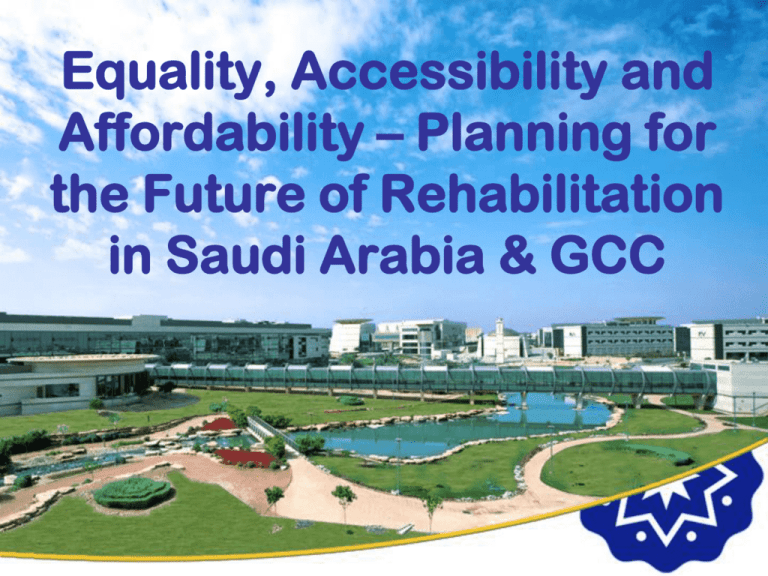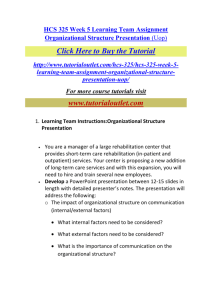Ankle Joint Distraction
advertisement

Equality, Accessibility and Affordability – Planning for the Future of Rehabilitation in Saudi Arabia & GCC Abdullah Bin Zarah Executive Director of Clinical Affairs Director of Business Development Sultan Bin Abdulaziz Humanitarian City www.humanitariancity.org.sa Health-Care A physician is obligated to consider more than a diseased organ, more even than the whole man - he must view the man in his world - Harvey Cushing A Short History of Medicine 2000 B.C. - "Here, eat this root." 1000 B.C. - "That root is heathen, say this prayer." 1850 A.D. - "That prayer is superstition, drink this potion." 1940 A.D. - "That potion is snake oil, swallow this pill." 1985 A.D. - "That pill is ineffective, take this antibiotic." 2000 A.D. - "That antibiotic is artificial. Here, eat this root." ~Author Unknown Health is a state of complete physical, mental and social wellbeing and not merely the absence of disease or infirmity. WHO Rehabilitation Is the right to equitable and affordable healthcare and rehabilitation services a right or a benefit? I believe it to be a fundamental right for a citizen to be able to access equitable and affordable healthcare. Countries needs to put their strategic plans and implementation actions and executing programs to fulfill that goal. HealthCare - Principles CONSIDER THOSE THREE PRINCIPLES WHEN YOU STRATEGIZE/PLAN Equality – That everyone is able to access a base level of healthcare services regardless of any other criteria. Accessibility – Regardless of location, each resident has access to comparable healthcare services. Affordability – A mechanism is in place that ensures affordability for all residents. Whether it is through a public or private options or a combination of both. Health Care Trends • Gradually rising share of aging population. Currently it is estimated that 994,512 or 4.2% of population are classified at 60+. By 2015, it is estimated this group will compromise 4.5% of population which translates to a growth of 327,506 to 1,322,017. This age group require more frequent and expensive intensive interventions. • 95% of strokes occur in people age 45 and older, and two-thirds of strokes occur in those over the age of 65. • The risk of stroke is two-and-a-half times in people with diabetes. Research shows that around 66% of those who experience a stroke can benefit from receiving intensive rehabilitation. Health Care Trends • • • Cardiovascular diseases and Obesity are alarmingly increasing. Due to lifestyle we are now seeing strokes and MI in people as young as 30. According to WHO Saudi Arabia has one of the highest obesity rates with 35.6% population classified as over-weight. Prevalence of diabetes is at 22-25% according to WHO. Trauma and RTA. Highest rate of RTA accidents and mortality in the GCC. Rehabilitation Coverage 1. Acknowledged Deficiency 2. Fragmented services spread between multiple organizations. 3. No national strategy implemented. 4. No comprehensive interdisciplinary approach. 5. Majority of organizations are either charitable or not-for-profit. Interdisciplinary Vs. Multidisciplinary Sultan Bin Abdulaziz Humanitarian City a Role Model • Multidisciplinary • Program and Outcomes Specific • Focus on discharge Plan • Combination of acute and rehab services under one umbrella • Planning for life-after rehab • Disability Advocacy, Public Policy and Community Awareness Campaigns. Sultan Bin Abdulaziz Humanitarian City. • Stroke, Amputee, TBI, SCI, Pediatrics, WHU programs. • With specialized programs such as Hippotherapy and Vital Stim. • Combined with a fully equipped acute hospital with O.Rs, Hemodialysis etc… • Working with national, regional and international organizations to further rehabilitation within Saudi Arabia and the GCC. Centralized Vs. Decentralized All has to be patient centered Pressing Issues • Inefficient scattered initiatives and programs. •lack of national registries, reliable and accurate data, statistics and specialized studies and weak research on disability, types, causes and available services, Efficacy of care provided, Continuum of care. • No national or even regional institution that collects reliable healthcare information on disease incidence and treatment effectiveness let alone rehabilitation. • Such an institute will provide decision makers with better information for planning and disease management and badly needed tool for forecasting futuristic trends and most efficient utilization of limited resources. • Currently rehabilitation is a neglected segment with no clear guidelines on health care provision. Pressing Issues •Provision of a comprehensive rehab coverage as part of the national health insurance scheme. •A effective national body to coordinate strategies and plans and their timely execution with all stakeholders/providers to ensure quality rehabilitation for the entire population. • Privatization initiatives, A heavy focus on Private Health Care provisioning means that less attention is paid to prevention. • The government must focus on prevention, education and primary health care. •Funding health care services is an ever increasing burden on governments and is a political struggle in most nations. Health Care Funding • Due to the global recession and even before, governments around the word are struggling to maintain health care levels as Health Care expenditure as a percentage of GDP continues to grow. • Normally charity organizations suffers most during financial hardships. • Cost effective approaches are sought by governments but at unsatisfactory outcomes. •More efficient economical options remains to be explored. Strategies…The Way Forward •Establish nationwide strategies and programs to tackle the disability from a global scientific approach. •Prevention is the fundamental aspect to tackle the future trends. •Develop a sustainable financial scheme to fund and provide rehabilitation coverage for all without any discrimination. •Clarify funding guidelines – so as to incentivize the private sector. •Rehabilitation care may be administered by both private and nonfor profit organizations. • Drug and equipment prices are negotiated by a single national authority. • All medical services and conditions are covered until the patient achieves optimal functional ability. Strategies…The Way Forward • With a greater focus on CBR and brining rehabilitation services to people in their area, rather then having to travel long distances. •Establishment of national or even regional database that collects relevant data so that it may be disseminated to interested stakeholders. •Provision of PPP insurance programs to include rehabilitation as a component of the insurance scheme. • Build own capacity by all stakeholders to offer the needed services at the right quality and magnitude. • An alternative to the fee for service model, instead health care providers reimbursed on the over all health outcomes of their patients. • Focus on prevention and education by governments. Strategies…The Way Forward • Invest in people, Numerous studies have shown the economic rationale for rehabilitation services. Governments and nations will save huge budgets over the long run. • There are savings of millions of dollars and riyals if comprehensive rehabilitation is provided at right time to the right people. • Multiple social benefits as these people can rejoin society as productive members. • Family members can be assured that their loved ones are taken care of and don’t have to devote time to take care of them. • More productive people means stronger and stable nations. Thank You A win-win situation for every-one!







